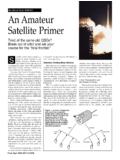Transcription of Uplink, Translation, Downlink - Photography
1 uplink , translation , Downlink How it all works By Brian B Donaldson, 24 May, 2011 Satellites are big repeaters in space. All they do if fall around the earth at a speed that will keep them in the same geographical location in their orbit. They were designed to receive signals from a point on the earth and send it back to another (or the same) point on earth. Or even satellite to satellite. They do not wonder the heavens freely however, they are controlled by stations location in the footprint they service. This paper is going to be a simple overview of how the signals are received in the satellite, translated to a different frequency, then rebroadcast back to earth. We are not going to design a satellite, nor are we going to discuss the intricacies of how they work or how they are built.
2 There are many satellite systems engineering books already devoted to that subject. We are just going to get a good solid understanding of what is going on up there. Below I have made a simple block diagram of the most simplistic relationship of what goes on inside a satellite. Like I said before, it is just a big repeater. A carrier frequency is received by the satellite, it is then translated to a lower frequency, and that is then transmitted back to earth. Simple enough. Don t worry about all the filters, the batteries, or solar cells, or amplifiers, or type and size of dish. That is mundane for this discussion, but just keep it in the back of your mind that all that is also include in the grand scheme of things. What s Up? Well, the transmitting signal from the earth will be somewhere between GHz and GHz.
3 In the United States and other parts of the world, the uplink frequency is limited to GHz to GHz. These are set by the International Telecommunication Union and controlled by a nations Communication Commission or equivalent. to is the extended part of extended Ku Band. One would have to look at a region to determine if extended Ku is used. If the extended Ku uplink is used then it would be appropriate to use an extended Ku Downlink . More on that in a minute. For now we are going to just concentrate on GHz and we will use that as a base for all out transmissions. Lost in translation ? So what does the satellite do with this GHz carrier it just received? Well, it pretty much does nothing to it. Maybe some filtering and amplifying, but it just passes in on to the next stage in the cycle: Translate it!
4 Here is where a lot of the magic is done. Remember I mentioned the ITU regions? Well, based on what region you are in will depend on what translation you will use. The translation is just a way of saying convert to a lower frequency. Let s talk about the United States first. The US is located in ITU Region 2. By the rules and regulations governing ITU Region 2, the translation frequency is set to GHz. We will take this translation frequency and subtract it from the received GHz carrier and that will be sent to the next stage. But what if we are not in the US? We will have to look at the rules and regulations that are governing the region that we are in. So let s move to Europe for a while which is in ITU Region 1. There they use the extended Ku Band.
5 That band starts at GHz. If they used the same translation as the US then something will go terribly wrong. So the ITU decided to use a translation frequency of GHz. What about ITU Region 3? A horse of a different color now. Their rules and regulations are very strict, like all the other regions, but they use a totally different translation . Theirs is on the order of GHz, or in some parts of that region GHz. It all depends on what kind of terrestrial communications is being used in that region. Going Down? The carrier that you produced has been sent to the satellite. It has been filtered, amplified, and sent to the translator. The translation frequency has been applied and now it is time to return the carrier to earth. But what frequency will our satellite receiver be listening to?
6 The math is simple, all we have to do is subtract the carrier frequency from the translation frequency and we then have the Downlink frequency. Again, all of this depends on the ITU region that you are in. So with this in mind, let s look at each region, the uplink carrier, the translation frequency, and then the results for the Downlink . ITU Region 1 uplink Frequency = GHz translation Frequency = GHz Downlink Frequency = = GHz ITU Region 2 uplink Frequency = GHz translation Frequency = GHz Downlink Frequency = = GHz ITU Region 3 uplink Frequency = GHz translation Frequency = GHz Downlink Frequency = = GHz With all of this in mind, there is always a caveat, so here it is. Each region can have modifications to the translation frequency.
7 With new satellites, a new frequency plan may be implemented. This paper just looks at the Ku Band frequency plan. C Band, X Band, and Ka Band have their own translation frequencies. However, the theory is sound and what you have read here, except for the actual number, is sound. For a complete list, but possibly not totally up to date, visit which will contain the locations of the majority of the satellites, they uplink , translation , and Downlink frequency plans. Here you will see that I have only touched on some of the translation plans. To get an understand of what happens to the Downlink carrier when it hits your satellite dish, read my paper Low Noise Blocks: Why So Many? Brian Donaldson is a freelance photojournalist and writer. He has lived in many countries and travels to find interesting stories and pictures.
8 Brian writes for the International Press Association.







